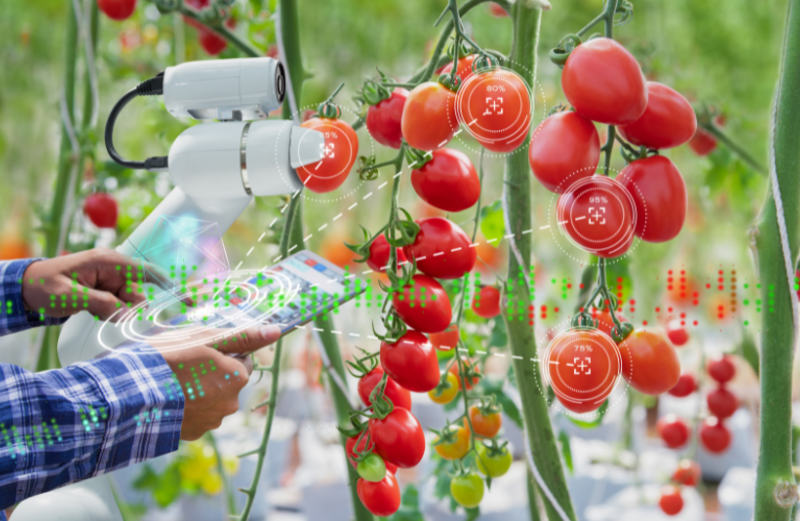Transforming African Agriculture Through Adoption Of Robotics Technology

This is the 26th post in a blog series to be published in 2023 by the APET Secretariat on behalf of the AU High-Level Panel on Emerging Technologies (APET)
The fourth objective of the African Union’s (AU) Agenda 2063 aims to ensure the well-being of African citizens, through promoting health and access to nutritious food. African countries, however, face significant challenges in accomplishing food security due to factors such as a growing population, urbanisation, and limited agricultural and food production capacity.[1] The number of people experiencing moderate to severe food insecurity on the African continent has increased from 512 million in 2014 to 794.7 million in 2021, affecting approximately 60% of the continent's population. Regrettably, Africa's current agricultural production trajectory does not align with the food security and nutrition targets outlined in the AU Agenda 2063.[2]
The agricultural sector stands as a cornerstone of African economies, serving as a multifaceted generator of income through foreign trade, employment opportunities, and vital sustenance. This underscores its immense potential to contribute significantly to crucial continental objectives, including poverty alleviation, hunger eradication, the promotion of intra-African trade and investment, acceleration of industrialisation and economic diversification, and sustainable resource and environmental management.[3] A pivotal catalyst for propelling economies forward, therefore, lies in the substantial growth of agricultural productivity, underpinned by technological advancements and strategic investments. These collective factors kindle optimism for a noteworthy upsurge in agricultural output across the African continent, particularly in the 21st century.
Despite the enormous potential of Africa as a breadbasket, the agricultural sector of the continent is faced with constraints that hinder its progress and the welfare of its populations. These barriers are multifaceted and often intertwined, contributing to a complex web of issues, which include low productivity, characterised by meagre yields attributed to outdated farming methods, especially weeding and harvesting, restricted access to contemporary agricultural technologies, and underutilisation of fertilisers and improved seeds.[4] African countries are confronted with alarming levels of food loss, with wastage rates reaching up to 50% during both pre-harvest and post-harvest stages.[5] This issue is exacerbated by the continent’s underdeveloped infrastructure, labour shortages, a scarcity of skilled farmworkers, and the unpredictable tropical climate.
Additionally, the adverse impacts of climate change, including droughts and floods, inadequate infrastructure encompassing road and storage facilities, and irrigation systems, shortage of agricultural financing, constrained market access, post-harvest losses, and the persistence of pests and diseases further compound the challenges. Drones are used for information gathering and to automate input application, similarly, to map based VRT. However, their use is often subject to strict regulations due to concerns about excessive input application, pesticide drift and aviation hazards.
The African Union High-Level Panel on Emerging Technologies (APET) notes that the quest for a promising and transformative frontier in African agriculture could be enhanced by the adoption and integration of robotics in agriculture through modern farming practices such as mechanisation. Robotics-based mechanisation holds significant promise, especially in the realm of harvesting, a critical component of Africa's economy and its pursuit of food security.[6]
As a policy imperative, APET recommends that AU Member States expedite the adoption of modern agricultural practices and techniques. This should include the integration of robotics into weeding and harvesting processes, to advance the continent’s quest for food security. For instance, many farms across the continent continue to rely on traditional manual weeding and harvesting methods. Manual weeding and harvesting entail the labour-intensive process of manually removing leaves and branches from plants, sometimes employing cutting tools, and carefully plucking fruit from the plants by hand. The introduction of robotic systems in the crop fields enables highly repeatable systematic actions, such as selective mechanical weeding (which reduces the proliferation of superweeds) and health monitoring of crop and soil. Thus, by embracing modern farming techniques, such as robotic harvesting, African farmers can revolutionise these practices and significantly contribute to enhancing food security in the region.[7] By embracing robotics-based mechanisation, African countries have the potential of addressing critical issues of poor harvesting practices and food wastage, bolster agricultural efficiency, and ultimately contribute to ensuring a sustainable and abundant food supply for its growing population.
APET observes that the adoption of robotics technology and especially robotics-based mechanisation in African agriculture further offers a promising solution to mitigate challenges associated with, severe rainfall, drought, microbial contamination, and physical damage that contribute to a staggering 1.3 billion tonnes of food wastage globally. This is because robots are equipped with advanced sensors and algorithms that can accurately assess crop ripeness, execute precision harvesting, and navigate challenging weather conditions. This not only reduces food losses but also enhances overall crop yields, thereby improving food security and livelihoods for farmers.[8]
Several AU Member States are leading the way in adopting agricultural robotics to modernise their farming practices. Kenya, a pioneer in this field, boasts of numerous startups dedicated to developing and deploying harvesting robots for various crops, including tomatoes, strawberries, and avocados.[9] Farmdroid, for instance, has engineered a robotic tomato harvester with a daily capacity of up to 20 tonnes.[10] In Nigeria, there is a growing interest in agricultural robotics, with large-scale farms utilising harvesting robots to boost productivity. AgroPro, for example, has introduced a robotic maize harvester capable of handling up to 10 hectares of maize daily.[11]
Ethiopia, with its vast agricultural sector and expanding population, is witnessing a rising demand for harvesting robots to combat labour shortages and enhance efficiency. Blue River Technology’s robotic tomato harvester can collect 20 tonnes of tomatoes daily while minimising fruit damage.[12] On the other hand, South Africa, a developed nation with a well-established agricultural industry, is harnessing harvesting robots to optimise efficiency and curtail post-harvest losses. Trimble's robotic strawberry harvester, for instance, can gather up to 10 tonnes of strawberries each day.[13] Further to this, Morocco, known for its sizable agricultural sector, is also embracing agricultural robotics to enhance efficiency and reduce post-harvest losses. For example, Naio Technologies has devised a robotic strawberry harvester capable of collecting up to 10 tonnes of strawberries daily, further illustrating the continent’s commitment to revolutionising its agricultural landscape through the adoption of technologies.[14]
Furthermore, some pioneering innovators in Africa are making significant strides in the development of robotic and mechanical systems designed to revolutionise the harvesting of diverse root crops. Cassava, a particularly challenging crop to harvest manually due to its labour-intensive nature, is a prime example. Manual cassava harvesting has posed a substantial hurdle in the path to commercialising this vital crop, as it entails arduous labour, often resulting in stress, physical discomfort, and time efficiency. In order to address this challenge, the Kwame Nkrumah University of Science and Technology (KNUST), in Ghana, has introduced the TEK mechanical harvester.[15] This groundbreaking technology has the remarkable capability to harvest one cassava plant in just one second, a stark contrast to the laborious 5 to 10 min required for manual harvesting, with the potential to significantly streamline the cassava harvesting process across the continent.
To encourage the adoption of crop harvesting robots in African agriculture, APET urges African policy and decision makers to facilitate financial support for farmers seeking to acquire harvesting robots through avenues such as government grants, loans, and subsidies. Additionally, AU Member States are encouraged to invest in research and development to enhance the affordability and accessibility of these robots for African farmers, through public-private partnerships and collaboration. Such collaborations could include sensitisation and awareness creation, demystifying of technologies especially robots, comprehensive training and capacity strengthening and technical guidance for farmers on how to effectively utilise harvesting robots.
Finally, APET recommends that AU Member States, especially policymakers develop supportive and enabling regulations aimed at reducing bureaucratic burdens, and providing tax incentives to farmers who invest in this technology. To this end, tailoring policies to specific crops or regions, such as avocados, cassava, and fruits, with targeted financial aid for robot adoption, could prove beneficial. Most importantly, provision of financial assistance and technical support to research and development organisations working on robotics for adoption and adaptation in African could be instrumental in overcoming barriers and reaping the technology's rewards.
In conclusion, APET proposes to AU Member States the development of small, low-cost autonomous crop machines for small- and medium-scale farms as part of the solution to the lack of agricultural labour in low- and middle-income African countries, with potential benefits especially for rural youth. Unfortunately, there are inadequate feasibility analyses for African countries. Nevertheless, the available literature indicates that the adoption of autonomous robots in these countries has the following potential benefits: reduced human labour requirement, where labour is scarce; lower costs and reduced economies of scale, ensuring accessibility of technologies to smaller farms using conventional mechanisation; and ability to use technologies in irregularly shaped fields in a cost-effective manner, avoiding the reshaping of rural landscapes into large rectangular fields, where traditional mechanisation is most efficient, a process that disrupts communities.
Featured Bloggers – APET Secretariat
Aggrey Ambali
Justina Dugbazah
Barbara Glover
Bhekani Mbuli
Chifundo Kungade
Nhlawulo Shikwambane
[1] https://www.nepad.org/blog/africa-addressing-food-security-dilemma-through-modern-agriculture-technologies
[2] https://unctad.org/news/blog-revitalizing-african-agriculture-time-bold-action
[3] https://www.mdpi.com/2077-0472/12/8/1236#:~:text=The%20results%20show%20that%20the,Africa%20suffered%20a%20substantial%20decline.
[4] Myeni, L.; Moeletsi, M.; Thavhana, M.; Randela, M.; Mokoena, L. Barriers Affecting Sustainable Agricultural Productivity of Smallholder Farmers in the Eastern Free State of South Africa. Sustainability 2019, 11, 3003. https://doi.org/10.3390/su11113003
[5] https://library.oapen.org/bitstream/id/968ec728-1a14-41a0-8229-f5a08e861b28/9781138393530_text.pdf
[6] https://www.imf.org/en/Blogs/Articles/2022/09/14/how-africa-can-escape-chronic-food-insecurity-amid-climate-change
[7] Kuta, Ł.; Komarnicki, P.; Łakoma, K.; Praska, J. Tomato Fruit Quality as Affected by Ergonomic Conditions While Manually Harvested. Agriculture 2023, 13, 1831. https://doi.org/10.3390/agriculture13091831
[8] Cheng, C.; Fu, J.; Su, H.; Ren, L. Recent Advancements in Agriculture Robots: Benefits and Challenges. Machines 2023, 11, 48. https://doi.org/10.3390/machines11010048
[9] Pedersen, S.M. & Fountas, Spyros & Have, H. & Blackmore, Simon. (2006). Agricultural robots—System analysis and economic feasibility. Precision Agriculture. 7. 295-308. 10.1007/s11119-006-9014-9.
[10] https://kenyaomf.webdev.comunity.me/
[11] https://www.futurefarming.com/tech-in-focus/robots-grow-50-hectares-of-maize-autonomously/
[12] Seo, D.; Cho, B.-H.; Kim, K.-C. Development of Monitoring Robot System for Tomato Fruits in Hydroponic Greenhouses. Agronomy 2021, 11, 2211. https://doi.org/10.3390/agronomy11112211
[13] https://eandt.theiet.org/content/articles/2019/06/strawberry-picking-robots-to-gather-fruit-for-wimbledon-fans/
[14] https://www.naio-technologies.com/en/news/a-unique-5-year-warranty-in-the-agricultural-robot-industry/
[15] https://www.tekcassavaharvester.com/blog/tek-mechanical-cassava-harvester/


